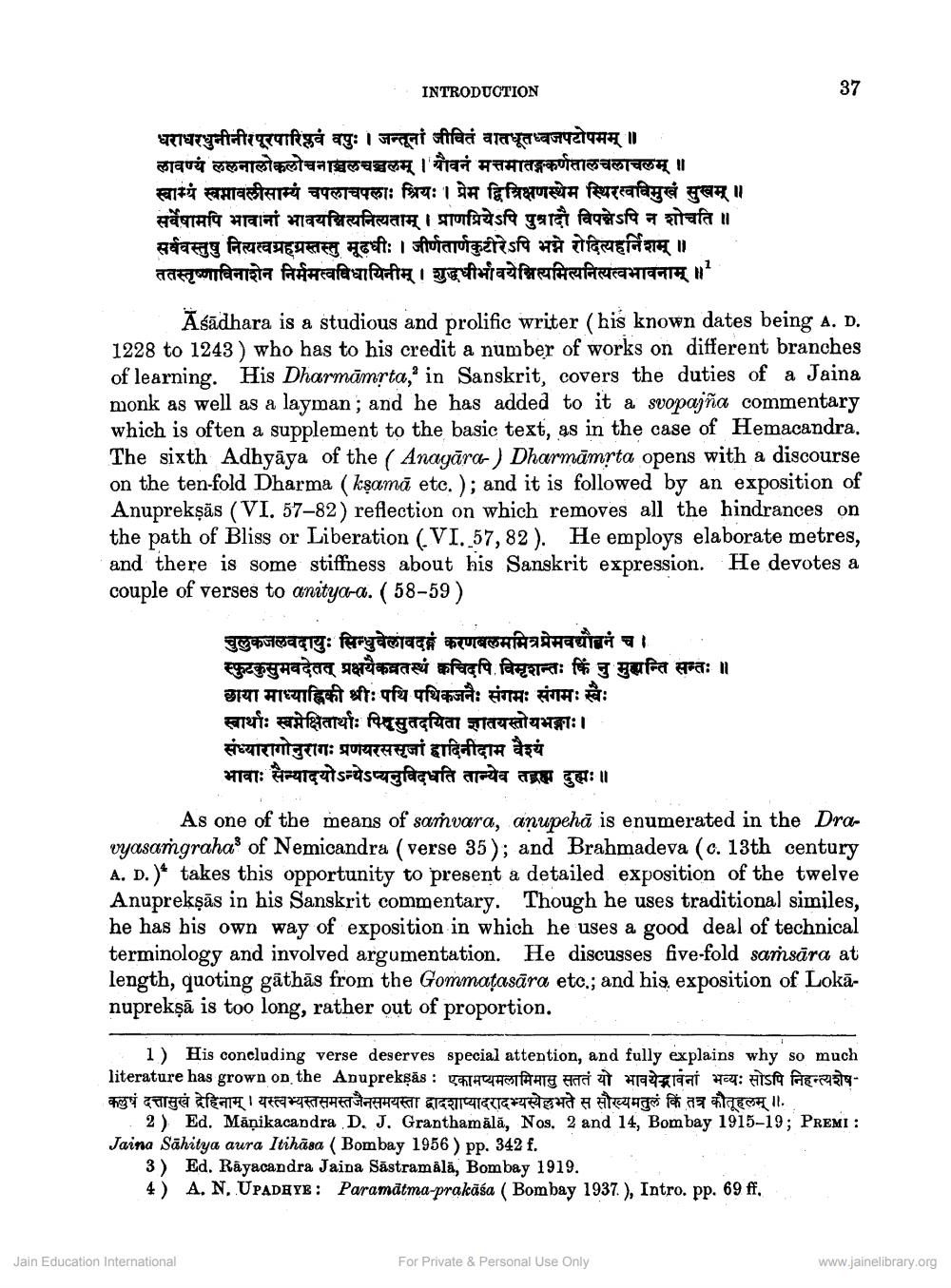________________
INTRODUCTION
धराधरधुनीनीरपूरपारिप्लवं वपुः । जन्तूनां जीवितं वातधूतध्वजपटोपमम् ॥ लावण्य ललनालोकलोचनाञ्चलचञ्चलम् । यौवनं मत्तमातङ्गकर्णतालचलाचलम् ॥ स्वाम्यं स्वमावलीसाम्यं चपलाचपलाः श्रियः । प्रेम द्वित्रिक्षणस्थेम स्थिरस्वविमुखं सुखम् ॥ सर्वेषामपि भावानां भावयनित्यनित्यताम् । प्राणप्रियेऽपि पुत्रादौ विपन्नेऽपि न शोचति ॥ सर्ववस्तुषु नित्यत्वग्रहग्रस्तस्तु मूढधीः । जीर्णतार्णकुटीरेऽपि भन्ने रोदित्यहर्निशम् ॥ ततस्तृष्णाविनाशेन निर्ममत्वविधायिनीम् । शुद्धधी वयेन्नित्यमित्यनित्यत्वभावनाम् ॥
Asādhara is a studious and prolific writer (his known dates being A. D. 1228 to 1243 ) who has to his credit a number of works on different branches of learning. His Dharmāmrta," in Sanskrit, covers the duties of a Jaina monk as well as a layman; and he has added to it a svopajña commentary which is often a supplement to the basic text, as in the case of Hemacandra, The sixth Adhyāya of the Anagāra ) Dharmāmrta opens with a discourse on the ten-fold Dharma ( kşamā etc.); and it is followed by an exposition of
Anupreksās (VI. 57-82) reflection on which removes all the hindrances on the path of Bliss or Liberation (VI. 57, 82). He employs elaborate metres, and there is some stiffness about his Sanskrit expression. He devotes a couple of verses to anitya-a. ( 58-59 )
चुलुकजलवदायुः सिन्धुवेलावद करणबलममित्रप्रेमवद्यौवनं च। । स्फुटकुसुमवदेतत् प्रक्षयैकव्रतस्थं क्वचिदपि विमृशन्तः किं नु मुह्यन्ति सन्तः ॥ छाया माध्याहिकी श्रीः पथि पथिकजनैः संगमः संगमः स्वैः स्वार्थाः स्वमेक्षितार्थाः पिदसुतदयिता ज्ञातयस्तोयभङ्गाः । संध्यारागोनुरागः प्रणयरससृजां हादिनीदाम वैश्य भावाः सैन्यादयोऽन्येऽप्यनुविदधति तान्येव तब्रह्मा दुह्मः॥
As one of the means of samvara, anupehā is enumerated in the Dravyasamgrahas of Nemicandra (verse 35); and Brahmadeva (c. 13th century A. D.)* takes this opportunity to present a detailed exposition of the twelve Anuprekşās in his Sanskrit commentary. Though he uses traditional similes, he has his own way of exposition in which he uses a good deal of technical terminology and involved argumentation. He discusses five-fold samsāra at length, quoting gāthās from the Gommațasāra etc., and his, exposition of Lokānuprekşā is too long, rather out of proportion.
1) His concluding verse deserves special attention, and fully explains why so much literature has grown on the Anupreksas : एकामप्यमलामिमासु सततं यो भावयेद्भावनां भव्यः सोऽपि निहन्त्यशेषकलुषं दत्तासुखं देहिनाम् । यस्त्वभ्यस्तसमस्तजैनसमयस्ता द्वादशाप्यादरादभ्यस्येल्लभते स सौख्यमतुलं किं तत्र कौतूहलम् ।।.
2) Ed. Manikacandra D. J. Granthamālā, Nos. 2 and 14, Bombay 1915-19%; PREMI : Jaina Sāhitya aura Itihāsa (Bombay 1956 ) pp. 342 f.
3) Ed. Rayacandra Jaina Sastramāla, Bombay 1919. 4) A. N. UPADHYB: Paramātma-prakāśa ( Bombay 1937.), Intro. pp. 69ff,
Jain Education International
For Private & Personal Use Only
www.jainelibrary.org




